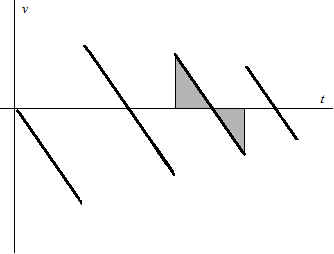Math Is Fun Forum
You are not logged in.
- Topics: Active | Unanswered
Pages: 1
#1 2007-09-09 04:44:20
- Daniel123
- Member

- Registered: 2007-05-23
- Posts: 663
Bouncing Ball
Ok I am getting a bit confused here..
I have some questions for homework:
a) Describe how you would obtain the data for a displacement-time graph for a bouncing ball if a motion sensor was not available.
b) Sketch a velocity-time graph for a bouncing ball from the moment it is released until its fourth impact with the ground. Take upward as positive. Indicate on your graph two areas that represent the height of the second bounce.
c) Sketch a velocity-time graph for a ball that is thrown vertically up into the air from the moment that it leaves the hand until it is caught back at the same horizontal level. Take upwards as positive.
The thing that is mainly confusing me is the direction.. "Take upward as positive".. does that mean that the velocity goes into negative?... and is the displacement from the starting point of the ball i.e where it was relesead from? And does the velocity-time graph drop straight to 0 when the ball lands?
Aaahh I'm tired... someone unconfuse me please.
Thanks.
Offline
#2 2007-09-09 05:27:34
- JaneFairfax
- Member

- Registered: 2007-02-23
- Posts: 6,868
Re: Bouncing Ball
(a) No idea.
(b)

(c)

The velocity is positive if the ball is going up and negative if its coming down.
Offline
#3 2007-09-09 05:27:55
- mathsyperson
- Moderator

- Registered: 2005-06-22
- Posts: 4,900
Re: Bouncing Ball
Velocity can go negative because it is essentially speed with a direction.
If you define up as being positive, then a ball travelling downwards would have negative velocity.
Just before the ball lands it would have a negative velocity, then when it lands the velocity would quickly go back to 0 and then up to some positive velocity which depends on how bouncy the ball is.
As for the first question, I would guess that zero-displacement is when the ball is on the ground, but it should really say in the question unless it's poorly worded.
Edit: Gah, post collision.
Why did the vector cross the road?
It wanted to be normal.
Offline
#4 2007-09-09 05:31:51
- Daniel123
- Member

- Registered: 2007-05-23
- Posts: 663
Re: Bouncing Ball
Ahhh! thanks!
Quick query... for part c), why does the velocity decrease? Wouldn't it increase at first due to acceleration, and then start to decrease?
Offline
#5 2007-09-09 09:27:43
- mathsyperson
- Moderator

- Registered: 2005-06-22
- Posts: 4,900
Re: Bouncing Ball
It depends where you start from. Jane's graph is starting from when the ball leaves the thrower's hand. If you want it to start a bit earlier then yes, it would begin at 0 and rapidly go up to the positive peak, at which point it would follow Jane's line.
Why did the vector cross the road?
It wanted to be normal.
Offline
#6 2007-09-09 11:43:01
- Ricky
- Moderator

- Registered: 2005-12-04
- Posts: 3,791
Re: Bouncing Ball
a) Describe how you would obtain the data for a displacement-time graph for a bouncing ball if a motion sensor was not available.
Repeated controlled trials is the easiest way. Or a video camera, even better. Since there is no specification as to what you can and can't do, put a thing that beeps inside the ball, fix 3 sound recording devices in an equilateral triangle around it, and then use computer software to triangulate the position.
"In the real world, this would be a problem. But in mathematics, we can just define a place where this problem doesn't exist. So we'll go ahead and do that now..."
Offline
Pages: 1